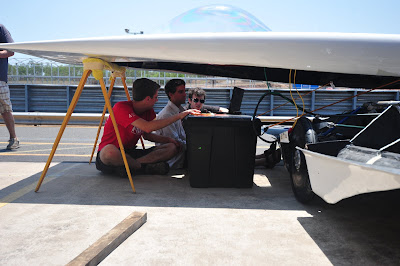At the end of Day 6, we laid out our ole' trusty blue tarp at a campground in Glendambo and slept there*. We woke up to a sky full of clouds and misery.
Our scout car drove south, seeking sunnier skies. The rest of the team, with our trailered car, followed scout forward until we found a nice, flat spot with decent sun. After charging our pack from the array, we trailered the car
back a couple hundred kilometers and proceeded to drive Chopper forward until we hit Port Augusta. Along the way, we encountered plenty of rolling hills, cattle grates, gusts of wind, and fast road trains.
Waiting for the clouds to break during our morning charge:
Solarcars were not allowed to drive south of Port Augusta after a certain time, so we trailered Chopper and took our convoy south to Adelaide.
We dropped out bags off at Quest in Adelaide and devoured a Lebanese meal. As you may know, Adelaide means partytime!, so we proceeded to meet up with other teams and celebrate the end of the race.
On Sunday, we drove up to the WSC finish line in Victoria Square. Rachel, Andy, and Annette then dashed off to the airport to catch their flights home. The rest of the team cleaned out our support vehicles, packed our supplies, and got ready to ship the trailer home.
That night, we attended the awards ceremony and got to congratulate the seven teams that finished the race without trailering. I'd like to give kudos to the UMichigan team not only for performing well, but also for embodying the spirit of the race and giving us help when we needed it. Thanks, UM, for lending us battery modules. You da best.
The race results were released that night, and we saw that we finished 16th out of the 37 (or 35?) competing teams.
The next morning, we flew out of Adelaide and encountered various mishaps at the Sydney airport and at LAX. We are now safely in Cambridge :D
We are humbled by the turn of events that happened in WSC 2011: hellish circumstances, a gracious donation, broken dreams, and new hope. Here's a big THANK YOU to everyone who contributed time, energy, money, materials, and well wishes to the team.
WSC 2011
MIT SEVT
(Both photos by Chris Pentacoff. Thanks dude.)
*At the end of Day 6 we drove our convoy north of Glendambo, desperate to find sun for an evening charge. While passing a non-MIT vehicle, our truck hit an emu which later died. Nameless Emu, we apologize deeply...




















































